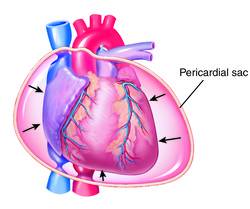 Cardiac tamponade is the compression of the heart that occurs when blood or fluid builds up in the space between the myocardium (the muscle of the heart) and the pericardium (the outer covering sac of the heart).
Cardiac tamponade is the compression of the heart that occurs when blood or fluid builds up in the space between the myocardium (the muscle of the heart) and the pericardium (the outer covering sac of the heart).
Alternative Names
Tamponade; Pericardial tamponade
Causes, incidence, and risk factors
In this condition, blood or fluid collects within the pericardium. This prevents the ventricles from expanding fully. They cannot fill enough or pump blood.
Cardiac tamponade can occur due to:
- Dissecting aortic aneurysm (thoracic)
- End-stage lung cancer
- Heart attack (acute MI)
- Heart surgery
- Pericarditis caused by bacterial or viral infections
- Wounds to the heart
Other potential causes include:
- Heart tumors
- Hypothyroidism
- Kidney failure
- Radiation therapy to the chest
- Recent invasive heart procedures
- Recent open heart surgery
- Systemic lupus erythematosus
Cardiac tamponade occurs in approximately 2 out of 10,000 people.
Symptoms
- Anxiety, restlessness
- Chest pain
- Radiating to the neck, shoulder, back, or abdomen
- Sharp, stabbing
- Worsened by deep breathing or coughing
- Difficulty breathing
- Discomfort, sometimes relieved by sitting upright or leaning forward
- Fainting, light-headedness
- Pale, gray, or blue skin
- Palpitations
- Rapid breathing
- Swelling of the abdomen or other areas
Additional symptoms that may be associated with this disease:
- Dizziness
- Drowsiness
- Low blood pressure
- Weak or absent pulse

Signs and tests
There are no specific laboratory tests that diagnose tamponade. Echocardiogram is the first choice to help establish the diagnosis.
Signs:
- Blood pressure may fall (pulsus paradoxical) when the person inhales deeply
- Breathing may be rapid (faster than 12 breaths in an adult per minute)
- Heart rate may be over 100 (normal is 60 to 100 beats per minute)
- Heart sounds faint during examination with a stethoscope
- Neck veins may be abnormally extended (distended) but the blood pressure may be low
- Peripheral pulses may be weak or absent
Other tests may include:


Treatment
Cardiac tamponade is an emergency condition that requires hospitalization. The purpose of treatment is to:
- Save the patient's life
- Improve heart function
- Relieve symptoms
- Treat the tamponade
Treatment usually involves a procedure to drain the fluid around the heart (pericardiocentesis) or to cut and remove part of the pericardium (surgical pericardiectomy or pericardial window).
Fluids are given to maintain normal blood pressure until pericardiocentesis can be performed. Medications that increase blood pressure may also help sustain the patient's life until the fluid is drained.
The patient may be given oxygen. This reduces the workload on the heart by decreasing tissue demands for blood flow.
The cause of the tamponade must be identified and treated. Treatment of the cause may include medications such as antibiotics, and surgery to repair the injury.

Expectations (prognosis)
Tamponade is life-threatening if untreated. The outcome is often good if the condition is treated promptly, but tamponade may recur.
Complications
Calling your health care provider
Go to the emergency room or call the local emergency number (such as 911) if symptoms develop. Cardiac tamponade is an emergency condition requiring immediate attention.
Prevention
Many cases are not preventable. Awareness of your personal risk factors may allow early diagnosis and treatment.
Sumber: dari sini
No comments:
Post a Comment